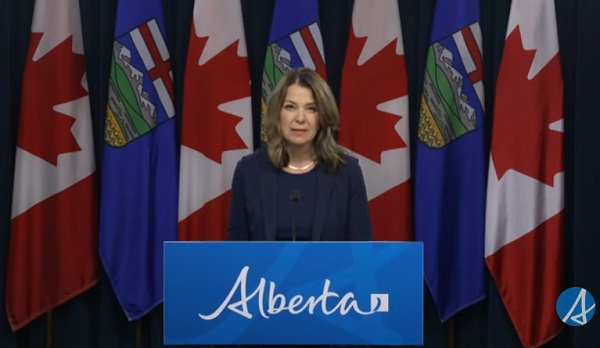Frontier Centre for Public Policy
Canada Needs a Mandatory National Service

From the Frontier Centre for Public Policy
Retired lieutenant-general and graduate of the Royal Military College of Canada, argues Canada should establish a mandatory national service for all citizens under 30 to rebuild patriotism, civic trust, and national readiness.
Our country can’t defend itself, and citizens aren’t patriotic enough to step up. It’s time to change that.
I joined the military at the age of 18, right out of high school. My parents were working class and couldn’t afford to pay my university tuition, so although I was accepted to several good schools, I chose the Royal Military College of Canada, where I’d be considered part of the military and receive an annual salary. During the academic year, our job was to study. Then in the summer, we did military training. We graduated as second lieutenants—entry-level officers—and then did four years of military service.
I loved RMC. That’s where I learned about discipline, leadership and teamwork. After graduating I served in an armoured regiment in Quebec City, the 12e Régiment blindé du Canada. Eventually, I became a three-star general—a senior commander—and represented Canada in NATO. The military is where I met my wife, who served as a major in the Royal Canadian Air Force. Our experiences gave us a sense of purpose that’s we’ve passed down in our family: today, two of my four kids serve in the Canadian military.
But they’re in the minority. On the whole, the Angus Reid Institute finds that young Canadians are more reluctant to fight for our country than older Canadians, and pride in our armed forces has dropped significantly, from 79 per cent in 2019 to 54 per cent now. That decrease is coupled with a lack of trust in our public institutions. As of 2023, only a third of Canadians were confident in the federal parliament, and barely half reported confidence in the justice system and courts. Some might argue that Canadians are taking more pride in our country now than ever—U.S. President Trump’s tariff threats brought us together and started the “Elbows Up” boycotts—but even that has started to ebb. In any case, we shouldn’t need Trump or any outside influence to make us patriotic. Real patriotism doesn’t come through ideas and slogans, but through leadership and action. That’s why I believe that now, more than ever, Canada needs to create a mandatory national service for all Canadians under 30 years old.
The Canadian Armed Forces are facing a shortage of between 14,000 and 16,000 personnel. Meanwhile, our Arctic coastline is poised to become a site of global geopolitical competition as world powers eye its critical minerals, oil, gas and fresh water. Russian and Chinese interests in the region are expanding, and the ice is melting, opening us up to a looming scramble for northern waterways and seabed resources. If anyone wanted to come into the North and seize our natural wealth right now, there would be little we could do to stop them, short of a strongly worded diplomatic protest. We don’t have the necessary troops to defend ourselves—and the ones we do, we can barely transport up there.
Meanwhile, our country’s political, economic, and military weight has atrophied, and Canada’s international reputation is getting weaker. We’re no longer a strong player on the world stage. For example, in August, when a group of European leaders travelled to Washington, D.C. to discuss the war in Ukraine and support President Zelenskyy, Canada was not at the table—even though we are only a short flight away. We need to rebuild Canadians’ confidence before we can once again wield the weight of a strong middle power abroad. And we can do that by ensuring that Canadians love their country and are prepared to serve it.
The good news is that recent polls show strong interest in a mandatory national service program—especially if it’s broadened beyond the military. In an Angus Reid survey, 43 per cent of people supported the idea of mandatory military service, but about 70 per cent of people approved of a year-long mandatory service in the fields of public health support, environmental support, youth services and civil protection.
There’s much that young people can gain from serving their country. Early in my military career, I spent two years on exchange in France, where I commanded army conscripts. It was the late 1970s, and at the time, almost every 18-year-old male was required to serve in the French military. We received new appelés, or conscripts, right off the bus. They had long hair and lacked any prior military training or knowledge. But after 12 months of basic training, I could have taken my troop to war and won. Some of them, who had shown leadership potential, ended up becoming crew commanders in charge of an armoured vehicle.
These conscripts gained more than just the skills to shoot a rifle or drive a tank; they learned about their country and the importance of defending and serving it. Having a job to do gave them discipline, and they picked up small lessons like the importance of nutrition and staying fit. These basic but foundational habits can help set a person up for life-long health and success.
In France, a lot of the appelés hadn’t travelled much. Once they joined the military, they performed military manoeuvres across the country. When young people get to know their country and its people better, a sense of national pride emerges, along with an understanding of why their country is worth defending in the first place. In Canada, national service could have a similar effect. Imagine a young man or woman from Quebec is sent to serve in Alberta, or vice versa. How much could they learn from that experience?
Several NATO nations already have a mandatory national service system in place, including Lithuania, Estonia, Norway, Finland and Denmark. Lithuania’s system, which seeks volunteers and then uses a lottery to fill the remaining quota, is only for the military and applies to men ages 19 to 26. Estonia conscripts all men between 17 and 27, but other public service jobs are options for those with religious or moral reservations. Meanwhile, Norway’s highly selective conscription program selects several thousand of the most eligible men and women up to the age of 44, granting the nation 3.5 times more military personnel per capita than Canada.
If we’re going to have a national service program, we’ll need leaders in government to create a framework for it. In Canada, the federal government could designate several different streams of work, including defence, conservation, emergency and disaster response, health care, social services, digital infrastructure and youth development. When a young person turns 18, they would register for national service and suggest what stream they might prefer. If more people register than needed, a lottery system could determine who serves and in which stream. Those selected would enter training and take courses on civics and Canadian history, as well as stream-specific skills. They would then be deployed to a community, where they would serve for a year. Deferral beyond age 18 could be an option in some cases, as long as young people still entered service before a certain age, like 25 or 30.
Getting a system like this off the ground would require resources, training capacity and federal coordination, but it would be a worthwhile effort. Canada is faces severe wildfire seasons, an expanding cybercrime landscape and declining biodiversity. Our health-care system is anticipating a shortage of 117,600 nurses by 2030. Young people would emerge from service with a stronger sense of responsibility for their nation and the foundational skills necessary to help address the country’s biggest problems. And of course, those who choose to serve in the military could be added to the reserve, which would place Canada in a stronger position to defend itself in an increasingly aggressive world.
I envision national service as a paying job, which would make it more attractive to young people. And there could be other incentives for them to join—financial support for university, for instance, or guaranteed employment after service. Permanent residents could get a faster path to citizenship.
Citizenship in this incredible country comes with benefits, but also responsibilities. Once every young Canadian has worn a maple leaf on their shoulder, I think they’ll feel pride for their country—something that can unite us all and help Canada achieve its fullest potential.
Michel Maisonneuve is a retired lieutenant-general who served Canada for 45 years. He is a senior fellow at the Frontier Centre for Public Policy and author of In Defence of Canada: Reflections of a Patriot.
Business
Steel Subsidies Are The New Money Pit Burying Taxpayers

From the Frontier Centre for Public Policy
By Conrad Eder
The federal and Ontario governments’ $500 million loan to Algoma Steel exemplifies costly corporate welfare, with taxpayers bearing risks that private investors avoid, continuing a decades-long pattern of subsidies that distorts markets and burdens Canadians.
Governments call subsidies an economic strategy, but Canadians know they’re just another way to raid their pockets
Another day, another giveaway. This time, it’s Algoma Steel.
Despite the company’s market capitalization of roughly $500 million at the time, the governments of Canada and Ontario extended a loan equal to that amount—an extraordinary and objectively questionable move that isn’t just bad policy, but a sign that elected officials don’t know how to support businesses.
Officials justify the loan by claiming it will help Algoma refocus on its domestic market, lessening its reliance on the United States. Yet the fastest and most efficient way to execute such a strategy would involve doing so with private capital. Private markets allocate capital efficiently because investors directly bear the consequences of their decisions. Companies that cannot secure private funding typically lack a viable business model or face fundamental structural problems that subsidies will not solve.
Even if Algoma has a credible plan for pivoting its operations, the fact that taxpayers are shouldering risks private investors refuse to bear raises serious concerns. Canadians have a right to question whether this is a sound investment or just another costly political decision dressed up as economic strategy.
This isn’t the first time the company has leaned on public funds. Over the past three decades, Algoma has received more than $1.3 billion in government bailouts and subsidies, including $110 million for restructuring in 1992, $50 million in 2001, $60 million in 2015, $150 million in 2019, $420 million in 2021, and now $500 million in tariff-relief loans. That kind of prolonged public support makes it difficult to argue Algoma operates on a level playing field.
Proponents may argue that since Algoma continues to operate and provide employment, it proves government intervention works. But they ignore the enormous opportunity cost of these subsidies—costs largely hidden from public view. Every dollar spent propping up one company is a dollar that can’t fund other priorities, whether health care, education, infrastructure, or tax relief.
How will Ottawa and Queen’s Park cover their latest $500 million pledge? There are limited options. They may choose to forgo funding other priorities, borrow the money they just lent to cover other commitments, or monetize the debt by printing money or financing it through the central bank. In any case, Canadians are left worse off, whether by higher taxes, reduced services, or inflationary pressures. That’s the real cost of corporate subsidies, borne not by the companies that benefit, but by the public that pays.
But what if Algoma Steel faces further economic pressures, or its plans to refocus on domestic manufacturing fall through? Are we to expect that, having committed $500 million, the government will walk away? History suggests otherwise. More likely, officials will try to protect their investment regardless of the cost. It’s a slippery slope, one that often leads to even larger bailouts down the road.
Instead of selective corporate welfare, Canada should pursue policies that benefit all businesses: reducing regulatory burdens, lowering corporate tax rates, and eliminating trade barriers. These broad-based reforms create conditions where efficient companies thrive while inefficient ones face appropriate market discipline. The goal should be to make Canada more competitive overall, not just more generous to the few firms with political clout.
Adding insult to injury, this government’s simultaneous interventionism and protectionism places twice the burden on Canadians. First, taxpayers subsidize Algoma’s operations. Second, they pay premium prices for steel products thanks to federally imposed import tariffs introduced in recent years to shield domestic producers from lower-priced foreign steel. We are, in effect, subsidizing Algoma Steel to produce so that we can turn around and buy from them at higher prices than steel could be purchased from international competitors, if not for the tariffs. It’s a double hit to Canadians’ wallets.
Government officials invoke national security arguments to justify these measures, but in reality, they are engaging in the same economic protectionism they decry. During Trump’s first presidency, Canadian politicians rightly condemned similar American steel tariffs as protectionism disguised as security concerns. Now, Canadian officials are making identical arguments to defend their own policies.
While politicians warn about future threats to the country’s steel supply, it isn’t foreign governments restricting access. Ottawa has imposed its own import tariffs, limiting steel imports from abroad. The real barrier to securing steel supply isn’t an export ban. It’s Canada’s own trade policy.
Our own production capacity further weakens the government’s case. With companies like ArcelorMittal Dofasco and Stelco, Canada produces roughly 12.2 million metric tonnes of steel annually. That’s nearly enough to meet domestic demand. For everyday Canadians, this means alarms about steel shortages rings hollow.
This is not an endorsement of these other firms, as they have also received public funds, nearly $1 billion in recent years. In fact, Algoma might be disappointed not to have received more themselves. But it needn’t worry. With this government, another payout is likely just around the corner.
And once again, Canadians will foot the bill.
Conrad Eder is a policy analyst at the Frontier Centre for Public Policy.
Frontier Centre for Public Policy
Ottawa Should Think Twice Before Taxing Churches

From the Frontier Centre for Public Policy
Ottawa has churches in its crosshairs. A federal fiscal squeeze could strip religious organizations of tax breaks, crippling Canada’s community backbone
Proposals to revoke charitable status for faith-based groups would devastate the community services thousands rely on
Canada’s churches, synagogues, temples, mosques and charities like the Salvation Army are at the heart of our communities, offering hope, support and services to thousands. But a storm is brewing in Ottawa that could strip these vital institutions of their charitable status, threatening their very survival—and much of our country’s social fabric.
The 2025 House of Commons Standing Committee on Finance, which makes recommendations to shape the federal budget, dropped a bombshell in its prebudget report, an influential document often used to set priorities for the year ahead. It included two recommendations that could hit religious organizations hard.
The first is that the government revoke the charitable status of pro-life groups. These agencies are being singled out because of the support they provide to pregnant women who do not wish to abort their children.
The second is that the “advancement of religion,” one of the four long-standing categories under which Canadian charities qualify for registration, be eliminated. The recommendation was based on a single proposal by the B.C. Humanist Association, a provincial nonprofit organization in British Columbia that represents atheists, humanists, agnostics and non-religious people.
If included in the next federal budget, these ideas would strip religious organizations across Canada of tax exemptions, the ability to issue donation receipts and, if provinces follow suit, property tax breaks.
Why target these groups?
Ottawa desperately needs the cash. The federal government is on a spending binge of gargantuan proportions with no end in sight. Canada’s balance sheet is drenched in red ink, with no credible plan to address the structural budget deficit, which the C.D. Howe Institute, a Toronto-based policy think tank, estimates will reach a record $92 billion this year. While the tax exemptions amount to only between $1.7 and $3.2 billion annually, the temptation to grab what it can from churches may prove irresistible.
But it’s not just about the dollars. Religious institutions have increasingly faced criticism from secular voices in Ottawa and academia. The Catholic Church, for example, is still facing harsh criticism over its role in Canada’s residential school system and over recent allegations of unmarked graves of Indigenous children at some schools.
As for Protestant and Evangelical churches, public perception casts these institutions as clashing with modern societal norms. Critics claim that churches opposing abortion or prevailing views on human sexuality should be compelled to align with government policies on these issues.
The message seems to be: shape up or ship out. This isn’t just a policy debate; it’s a cultural attack on institutions that have shaped Canada for generations.
Despite the criticism, there are compelling reasons to preserve the charitable status of religious organizations.
First, a recent study by Cardus, a Canadian faith-based think tank, shows that for every dollar of tax exemption, religious groups deliver $10 in community services.
Second, religious congregations offer substantial intangible benefits of immeasurable value. They foster vibrant communities where individuals find friendship, emotional support and spaces to explore questions of meaning and purpose. They also provide opportunities for people to experience a sense of transcendence and spiritual connection.
When the current focus on materialism comes to an end, as it must, many Canadians will turn to the church for guidance in addressing the most profound questions about human existence.
Ottawa needs to get its fiscal house in order, not raid ours. It’s time for Canadians to speak up. Write to your MP, attend community forums and demand that the charitable status for religious organizations be preserved. Doing so will ensure that churches and other places of worship continue to serve Canadians for generations.
Pierre Gilbert, PhD, is an emeritus associate professor at Canadian Mennonite University and a senior fellow at the Frontier Centre for Public Policy. He is the author of Revoking the Charitable Status for the Advancement of Religion: A Critical Assessment and God Never Meant for Us to Die (2020).
-

 Agriculture2 days ago
Agriculture2 days agoFrom Underdog to Top Broodmare
-

 Health2 days ago
Health2 days agoSovereignty at Stake: Why Parliament Must Review Treaties Before They’re Signed
-

 Business2 days ago
Business2 days ago$15B and No Guarantees? Stellantis Deal explained by former Conservative Shadow Minister of Innovation, Science and Technology
-

 Uncategorized10 hours ago
Uncategorized10 hours agoTrump Admin Establishing Council To Make Buildings Beautiful Again
-

 Alberta2 days ago
Alberta2 days agoPremier Smith moves to protect Alberta in International Agreements
-

 Sports1 day ago
Sports1 day ago‘We Follow The Money’: Kash Patel Says Alleged NBA Ties To Mafia Just ‘The Start’ Of FBI Investigation
-

 Business1 day ago
Business1 day agoA Middle Finger to Carney’s Elbows Up
-

 Energy23 hours ago
Energy23 hours agoB.C. premier’s pipeline protestations based in fallacy not fact








